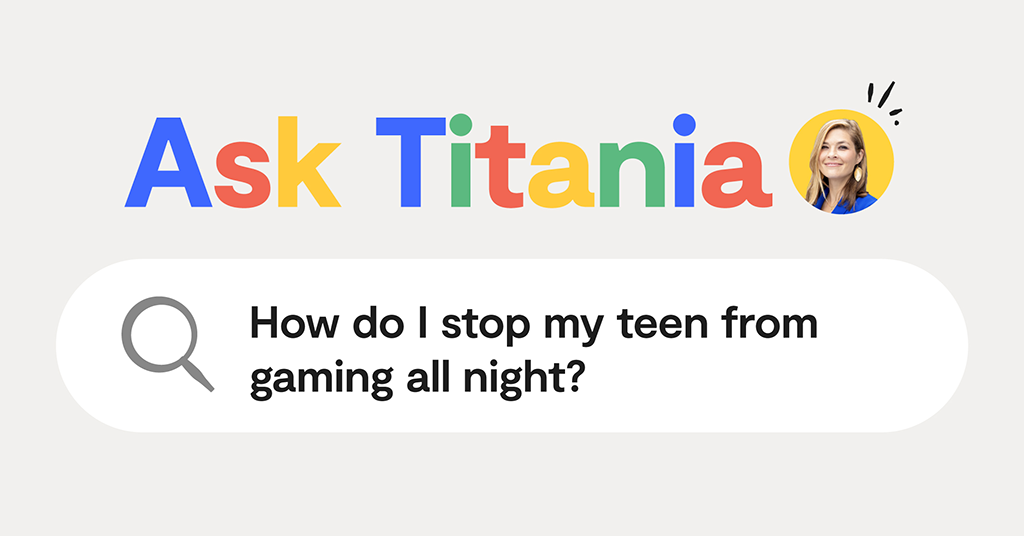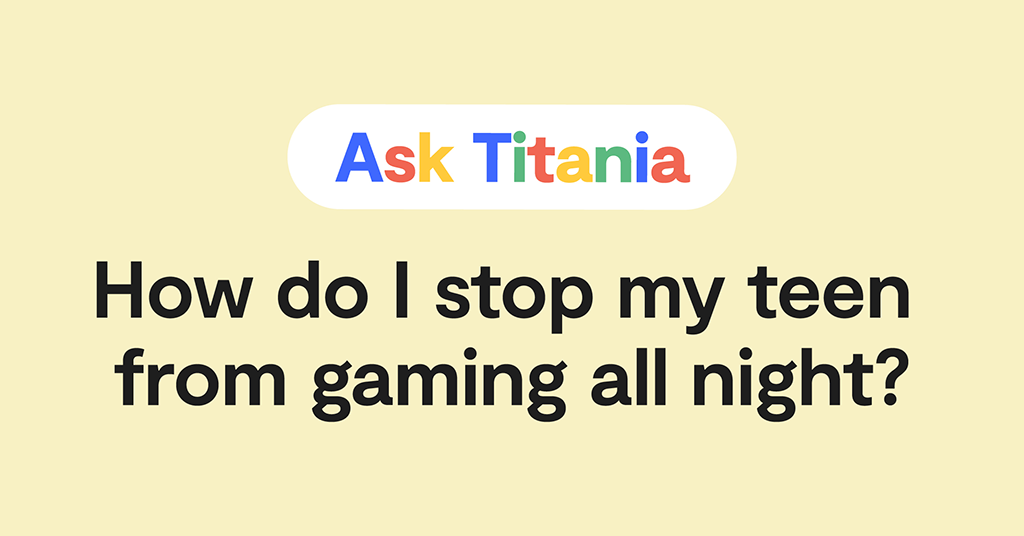
Dear Titania,
My 13-year-old loves video games — I’d go so far as to say obsessed. I know this isn’t an uncommon issue for kids his age, but I need some serious help. If left to his own devices, he’ll play all night, either Fortnite or Call of Duty with friends or even just by himself if no else is online. How do I not only stop the marathon sessions, but also help him to understand it’s important to set healthy boundaries?
Signed,
Vexed over video games
Dear Vexed Over Video Games,
Oh boy, do I feel this one. Video games are part and parcel of growing up today, for better or for worse, but that doesn’t make managing your child’s playing time any easier. And if they’re not playing games, then they’re watching tutorial videos on YouTube or watching other people play them on streaming platforms like Twitch. It’s a whole digital ecosystem, and it can be all-immersive.
Of course, allowing your child to play video games is totally fine (and so is not allowing them, for the parents who choose to abstain!). But it’s important to know when to step in and set limits — the earlier, the better, which is true for lots of tech gadgets.
When it comes to video games, the American Academy of Pediatrics recommends no more than 60 minutes on school days and 2 hours on non-school days. (This may give you some insight into where your kid falls on the playing spectrum.)
How Gaming Is Different Today
As long as there’s been video games (and that’s about 40ish years), kids have been hooked on them. From Pong on an Atari in the family living room to Super Mario Brothers on a Nintendo to today’s virtual reality headsets, the technology has been ever progressing. The self-control part of kids’ brains doesn’t fully develop until they’re 25, which means that video games present a pretty attractive obsession. And the games today are shinier, louder, and much more intense.
When you take that into account and couple it with the fact that gaming today is way more social than just having a friend over to play NBA Jam, you’ve got a recipe for obsession. Old video games used to be two players, max. Nowadays, games harness the power of the internet and can consist of hundreds of players all together at once, with both friends and strangers from around the world playing.
Of course, the pandemic didn’t help things, either, as kids relied on gaming as a liferaft to stay connected to friends they couldn’t see in person. Odds are, screen time rules also were relaxed, and reeling it back in can be hard.
Gaming Console Parental Controls Can Be Your Best Friend
So, what’s a parent to do? First, look to the consoles themselves. Video game companies know how addictive their products are, which is why they all provide parental controls to help families keep some sort of balance. PlayStation, Xbox, and Nintendo all have fairly robust controls you can take advantage of — and you definitely should!
With each, you can manage not only the all-important gaming hours (with custom schedules!) but also privacy features, who your child can chat with, how much money they can spend on games and upgrades, and more things you may not have even thought of.
Yes, it will require sitting down and watching a few videos on how they work, but it’s 100% worth your time.
The Dangers of Online Multiplayer Gaming
Online gaming in particular can be a little more dangerous than solo playing because it introduces something that every parent is probably afraid of: strangers over chat. First-person shooter games like Call of Duty and Fortnite rely heavily on headsets for players to communicate, but the other players can be complete strangers from around the world.
Not only can your kid be exposed to adults screaming at them, they could also hear inappropriate content, profanity, hate speech, and more. These adults may also potentially be predators, looking to strike up relationships with children in games and then move to a different platform to chat.
Bark Home Helps You Limit Online Gaming and More
If you’re more concerned about online gaming, the internet connection will be the most important thing to consider. The Bark Home — a small device that plugs into your home Wi-Fi router — lets you turn off the internet to Wi-Fi devices in your house. That can look like, for example, no Xbox multiplayer games after dinner and until noon the next day.
Why I love the Bark Home is because it’s not just a one-trick pony. You can also use it to block websites and apps on any device — like TVs, computers, and more. Screen time schedules are also available, so you can create custom rules like no Netflix during dinner, along with anything else you think needs limits.
Not only can your kid be exposed to adults screaming at them, they could also hear inappropriate content, profanity, hate speech, and more. These adults may also potentially be predators, looking to strike up relationships with children in games and then move to a different platform to chat.
Let’s Talk About Physiology For a Minute
Sure, video games are fun and kids love them, but kids also love potato chips and candy. Both are fine in moderation, but it’s important as a parent to encourage your child to get outside and move their bodies. Lack of physical movement can lead to not only physical issues but also emotional and mental health concerns like anxiety and depression. Doctors have been saying for years now that “sitting is the new smoking,” and sitting while playing video games definitely counts.
If you’re truly worried about your child falling into the throes of video game addiction, please do not hesitate to contact your child’s pediatrician to review your concerns and next steps. According to the American Psychiatric Association, “there are plenty of safe and effective treatments for video game addiction already in use.” So that’s encouraging.
Another helpful conversation to have surrounds brain chemistry, addiction, and emotions. Watch videos with your child that cover the pleasure centers of the brain and how powerful any addiction can be — thanks to what screens (Or sugar! Or anything else!) do to the reward centers responsible for dopamine, serotonin, adrenaline, and more.
Help your child understand that when sleep, behavior, physical activity, and relationships suffer as a result of video game time, that’s when humans need help regulating. It’s not their fault, it’s a powerful force that, if we don’t pay attention to it, can take control of our health and well-being. Tech can be a wonderful and entertaining tool, as long as WE remain in control of IT.
More Help
We often recommend tech contracts for a kid’s first phone, but you could also adapt one for video games to help set expectations. One other tip that I recommend for parents is to sit down with your kid while they’re playing and learn what they’re doing when they game.
Ask what games they like, see how they function. You may not become a video game fan, but as you’re in the process of helping to set boundaries, you’ll also learn more about something your child loves, and that’s always a good thing.
Read more
Bark helps families manage and protect their children’s digital lives.






